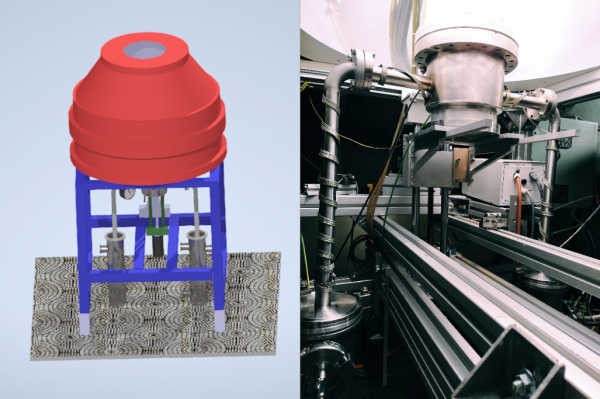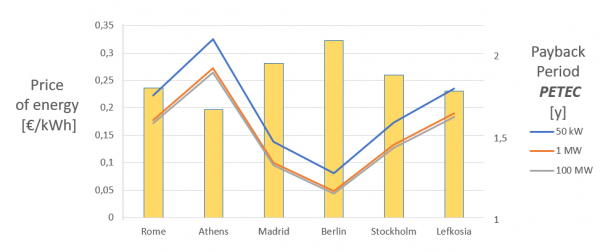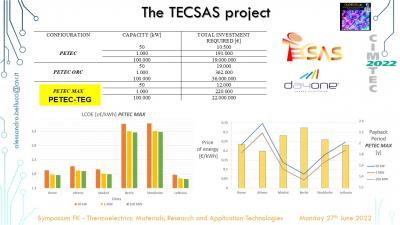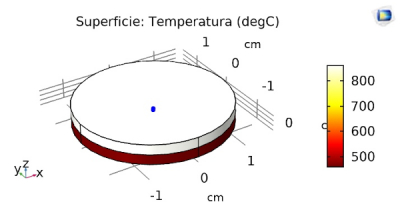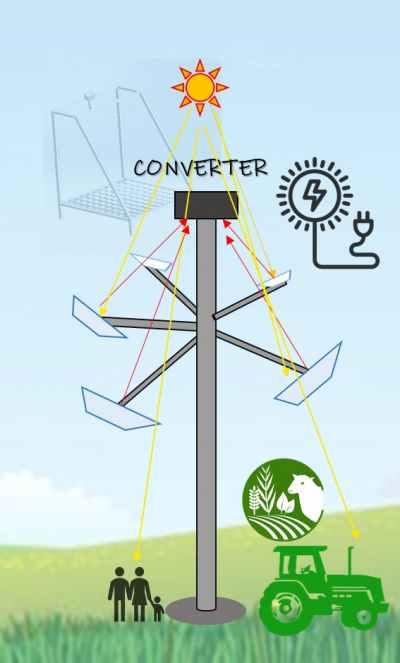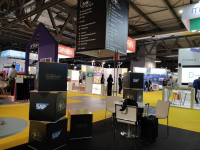Summary of Deliverable 1.3: Analysis of the performance of a small pilot system for demonstrating the technological feasibility
A new experimental setup has been specifically prepared for demonstrated the TECSAS technology using a laboratory solar furnace. A small thermal energy storage system was coupled to the thermionic converter to put in thermal contact the thermionic anode with a storage medium, i.e., molten salts. A mixture of Na/K/Li nitrates was selected to play the role of molten salts in the system due to the relatively low (nominal 120 °C) liquidus temperature.
The experiments validation consisted in the evaluation of the thermionic performances based on the inner elements used in the converter and in the consequent refining of the model. Moreover, more interestingly, the results about the use of molten salts, coupled to the anode of the thermionic receiver, were showed. The demonstration of the feasibility of this integration is successfully reported for this small-scale pilot system, with the analyses of the achieved temperatures, the melting period and the stored thermal energy, and the storage time.
Finally, these promising results allow confirming the future, advantageous and affordable applicability of the concept, even if a hard engineering work will be made for scaling-up the system. In the future, thanks to the fabricated setup, several improvements and/or different operating conditions (i.e., higher operating temperatures, smaller inter-electrode spacers, higher quantity of molten salts, presence of a more proper thermal insulation of the reservoirs, etc.) could be tested to even strengthen the concept and find the most recognized scenario of application (together with the product development roadmap and the business plan outputs).
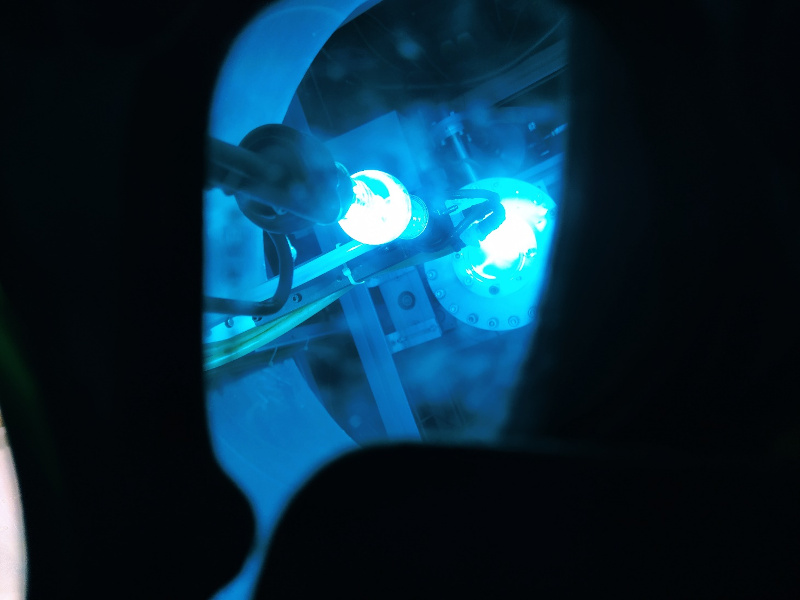
Summary of Deliverable 2.2: Business Cases for the Various Application Scenarios
This document initially presented three possible configurations for this type of technology based on the plant size (50 kW, 1 MW, 100 MW), each most suitable for a certain capacity and a particular branch of application.
Subsequently, the tools were presented, thanks to which it was possible to compare TECSAS technology with the state-of-the-art systems, and thus the technical model and the economic model: the former allowed us to identify, for each temperature, the material, via the physical property of work function, that ensured the best energy efficiency, while the latter was used to assess the impact on costs and revenues that each type of configuration at each scale studied could have, and thus how much they were actually worth, also assessing the different geographical location.
Finally, thanks to the numerical values obtained from the models, a discussion was carried on regarding the business cases of this technology, thus considering the most suitable configurations and scales for each application in order to optimise efficiency and show how much better TECSAS technology is potentially than current technologies.
Thanks to this study, the qualities of TECSAS technology have been made evident. It has excellent market possibilities, having been compared with its current main competitor, PV, and having been found to be more cost-effective, in particular for small scales. In fact, we have explained how its compactness and efficiency would make it the preferred state-of-the-art solution in this field, associated with low installation costs and practically zero operating costs, having a low payback time and thus soon becoming a source of profit.
On larger scales, in the absence of a suitable model that could reliably scale the data, it was not possible to reconfirm with certainty the convenience of this technology over the others, although an outline study has brought positive results, which nevertheless need reliable numerical confirmation.
In conclusion, the absolute versatility and wide assortment of configurations that characterize the TECSAS technology make it a competitive technology in the CSP business field that is likely to increase its portion of the market among renewable energy sources, which are already rapidly rising in themselves.
Summary of Deliverable 2.4: Business Model and Business Plan
In this document, a global scenario on the TECSAS technology is presented. By summarizing:
- we analysed the basic need, the problem that TECSAS aims to solve and how, both from a purely technical point of view and from the patent point of view of current intellectual property;
- we described the whole market scenario into which the TECSAS product is going to introduce itself, highlighting the limitations of state-of-the-art technologies and pointing out how the TECSAS product is going to make up for these shortcomings, both from an economic and technological point of view;
- we described the involved team, presenting both those who deal with the project from a technical point of view and those who deal with it from a business point of view, finally giving an overview of the figures to be hired for the foundation of the start-up and a preliminary organizational chart of it;
- we highlighted how the TECSAS product will meet the market, with which business model and through which network, thus emphasizing all suppliers, end users and stakeholders already in contact and supporters of this technology;
- we outlined the development roadmap, describing the next steps to be taken on one hand from the technology perspective, on the other hand from the business and future company's building point of view;
- we illustrated the risks that could be incurred, and presents a potential solution for each of them;
- we presented the economic and financial forecasts for the next 5 years, considering and estimating possible revenues, costs and need of financing.
Finally, according to the Eco-Fin projections, we concluded that, after the end of the project and the foundation of a new-co, the sales of TECSAS technology could start in 2025, after the achievement of the CE-mark. Initial customers are expected to be the families interested in reducing the cost of energy. However, in the first two years, not having started sales yet but already incurring expenses, external funds are needed (estimated about 500.000 €). These will mainly be used to finish R&D activities so that we can go to market and start sales.
For more information, please contact the project coordinator: or contact us by social media.
TECSAS project presented at CIMTEC 2022
During the invited talk of Dr. Alessandro Bellucci “Hybrid Thermionic-Thermoelectric Generators for Concentrated Solar Radiation: Technological Advances and Future Challenges” held at the international conference CIMTEC 2022, some of the TECSAS results have been presented in the context of a practical applications of thermionic-based technology in CSP plants. The audience appreciated the presentation and positive feedback from US academic spin-off has been obtained for the establishing of a future collaboration.
Summary of Deliverable 1.2: Results of the modelling activities for TECSAS technology on the 3 different scenarios of CSP plants
Results of the modelling activities for TECSAS technology on the 3 different scenarios of CSP plants
Summary of Deliverable 2.1: Market Requirements Document
In Deliverable 2.1 we present the preliminary market analysis of TECSAS technology and bring together information collected from the literature and the result of interactions with some of the key stakeholders in the sector.
TECSAS team joined Enlit Europe
In Milan, TECSAS team joined Enlit Europe, one of the main events about energy for the European actors in this sector.
Kick-off Meeting
TECSAS kick-off meeting took place on March 15th, 2021


